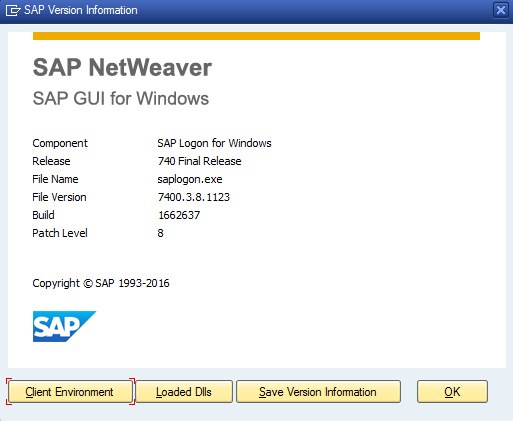

Resolution of host names and symbolic service names is done by the operating system's network layer. Simple connection strings need not to be resolved by the SAP GUI application.
Sap gui for mac plus#
Note that the port number for an SAP application server is by convention 3200 plus the two-digit SAP system number.Įxample with host name ( ) and symbolic service name (sapdpIWD): IP address and port number are marked with the prefixes '/H/' (for host) and '/S/' (for service). This information is sufficient for SAP GUI to open a direct TCP connection to a destination, e.g. In its simplest form, a connection string contains an IP address and a port number. an SAP system's application server, similar to an Internet URL describes a location for a web page. A connection string describes a connection address for a destination, e.g. Connection StringsĬonnection String is a technical term used within SAP GUI.
Sap gui for mac how to#
The documentation below is the official article from the SAP support site, and provides information on how to build connection strings that are fully supported by Qualibrate. To support advanced server configurations, Qualibrate allows to use other connection details such as the standard SAP connection strings. During the recording process, Qualibrate will extract the details of the connection normally by identifying the server name and system number of the SAP environment. Basically it is out-of-box installation and you will feel almost no difference than on Windows.Qualibrate records a “Connect to SAP” step when opening a new SAP GUI connection thru the SAP LogonPad. Run SAP GUI for Java and Eclipse ADT is more and more easy nowadays on Apple Laptop.
Sap gui for mac install#
Go into the eclipse, follow the steps on to install ADT toolsĪfter install ADT successfully, you can create a new ABAP project by choosing the SAP instance which configured in SAP GUI for Javaįollow the steps to create the ABAP Project, you are OK to use Eclipse ADT to connect to SAP instance. You can also point to other JDK to start Eclipse by changing the ist file, uncomment the -vm parameter. Note: Eclipse use it’s own JRE to start the IDE. I would suggest to install through homebrew: $ brew install -cask eclipse-javaĪfter installation, you can find it from Apple Launchpad and run from there:
Sap gui for mac download#
Now you can login to enjoy your SAP GUI for javaĮclipse supportes the M1 chip now, you may download the latest version (2021-09) from official website. Please ref this good article for connection string detail: Replace host name/IP and systemName with your system value. Ideally you could see success screen below:įind SAP Icon from Apple Launchpad, and double clickĬreate a new connection, configure from Advanced tab, and put the connection string like below: You can leave it no change in this screen or choose your own location You will see the installation guide screen and go ahead Note: I noticed the dmg file under installation path cannot be used, it might because of the M1 Chip difference with Intel Chip.

Navigate to the installation file path and run java command: $ java -jar So it’s a out of box installation and you just follow the installation guide step by step: Installation I understand in the late version of SAP GUI for Java 7.5 and the new 7.7, SAP Machine and JFX are embedded in the installation files, you don’t need install Open JFX now. which means you need set the Module path of JFX at the Installation Option step. In early version of SAP GUI for Java, we need install Open JFX to support the user interface of SAP GUI installation. but I noticed the homebrew installed version is for X64 instead of AArch64 SAP GUI for Java Note : you can also use Homebrew to install SAPMachine as well. Now check the java version, it come to SAPMachine now: zshrc file and add java home and path for SAPMachine $ open ~/.zshrcĪppend below information to the open file export JAVA_HOME=/opt/jdk/sapmachine-jdk-17.jdk/Contents/HomeĮxport PATH="/opt/jdk/sapmachine-jdk-17.jdk/Contents/Home/bin:$PATH" You will find the arm64 version Open JDK17 has been installedĭownload SAPMachine from, choose the MacOS aarch64 version SAP Machine 17 to downloadĪfter download, you can open the file and copy the content to local folder, for example : /opt/jdk, structure like below: Install Open JDKįor my testing the latest version of Open JDK can be used for SAP GUI client, suggest to install from Homebrew: $ brew install openjdkĪfter installation, check java and java home $ /usr/libexec/java_home -V You may choose one of the JDK to go ahead, simplest way is with OpenJDK. I have installed both JDK, and both of them are working to install SAP GUI and Eclipse. Standard JDK doesn’t support M1 chip yet. Recently I tried install SAP GUI for Java 7.7 into my M1 Mackbook Air.


 0 kommentar(er)
0 kommentar(er)
